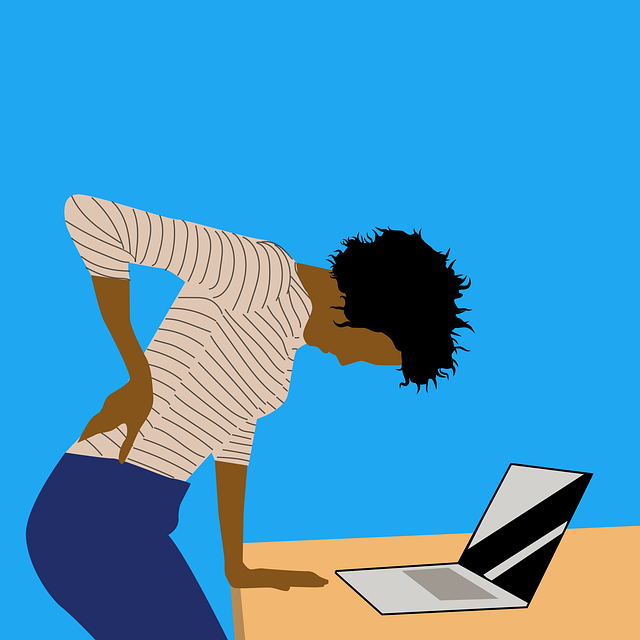Until receiving a diagnosis, you may have never heard of the term Lumbar Spine Spondylosis, nor know what it means. The following article explores lumbar spine spondylosis in greater depth, offering you information on the symptoms, causes and treatment of the problem. Hopefully, this article will answer all of your questions about lumbar spine spondylosis.
Lumbar spine spondylosis is commonly called Degenerative Disc Disease, which offers a little insight into the nature of the problem.
First, we need to understand a little about the anatomy of the spine to appreciate what lumbar spine spondylosis is. The spine is made up of 24 movable bones called vertebrae.
Each of these bones are separated by an intervertebral disc – a tough sac made up of strong cartilage, filled with fluid. These discs act as cushions to absorb the impact of movement and prevent the vertebrae from grinding against each other.
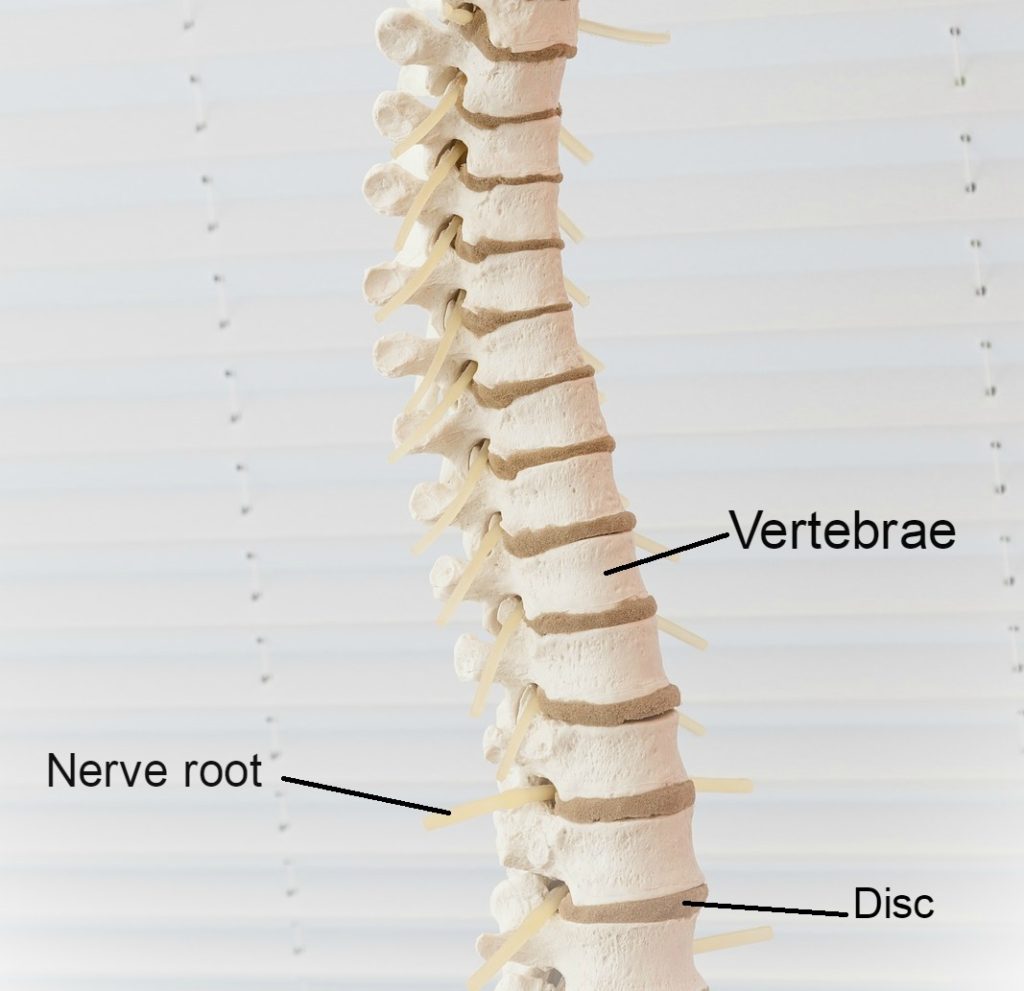
The spine not only functions to provide structure for our body, offering support for the body to complete movement, but it is also responsible for housing the spinal cord.
This “house” is called the spinal canal – a tunnel through the spine whereby the spinal cord runs. The spinal cord runs from your brain all the way down to the bottom of your back, supplying nerves throughout your entire body.
Your lower back is made up of 5 large lumbar vertebrae. These are called L1 to L5. L5 is the lowest vertebra in the spine. We name these discs based on the vertebrae above and below the disc. For example, if we are talking about the disc between L4 and L5, we would call it disc L4/L5.
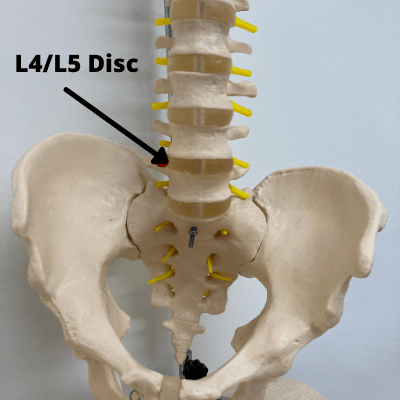
Degeneration is most frequently witnessed in these lumbar discs, as the lower back (the lumbar area) is consistently recruited as a pivotal site of movement.
Lumbar spine spondylosis is an umbrella term for a cluster of different problems, all relating to the deterioration of intervertebral discs and the consequential damage to the surrounding areas; in this case, the lumbar discs and the lumbar vertebrae.
Symptoms of Lumbar Spine Spondylosis
So, how can you identify whether you are experiencing lumbar spine spondylosis?
Well, it’s not always easy, as spondylosis can encompass many forms of age-related spinal deterioration. If you are experiencing the following symptoms, you may be suffering from lumbar spine spondylosis:
- Lower back pain: dull, aching pain which may flare-up, especially after movement
- Soreness: localised to the area of disc degeneration, often caused by inflammation
- Muscle spasms: pressure on the nerves can prompt spasms in the connecting muscles
- Leg pain/sciatica: when the disc degenerates substantially, there is no material to protect the spinal nerves which travel down the legs – this can cause pain or altered sensation in the leg
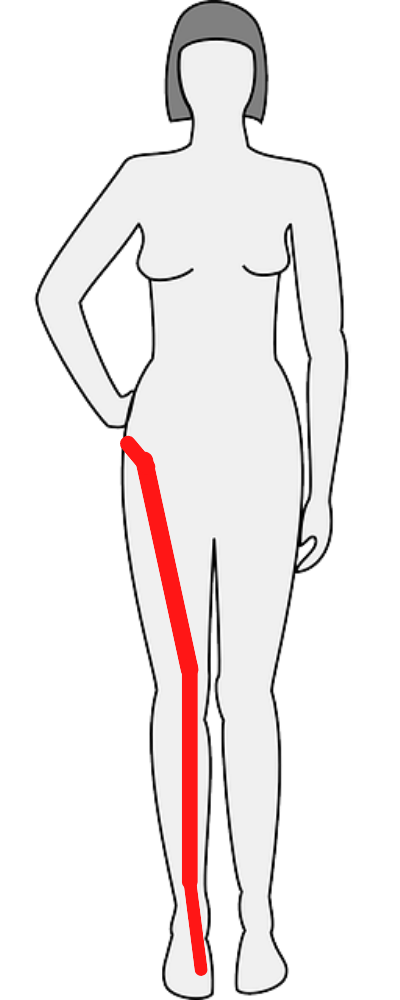
Because spondylosis encompasses all problems which stem from degenerated lumbar discs, the following list outlines examples of conditions which may occur as a result of disc deterioration:
- Spinal stenosis: when the spinal canal narrows, which restricts space around the spinal cord, leading to the pinching of nerve roots
- Sciatica: as the discs wear away, there is nothing to protect the sciatic nerve which runs down your spine, leaving it vulnerable to compression
- Disc herniation: when the outer layer of the disc deteriorates, allowing the inner jelly (nucleus) to rupture
- Spondylolisthesis: when one of the vertebra slips out of place, often resulting from spinal instability due to disc degeneration
Causes of Lumbar Spine Spondylosis
It is helpful to discuss how spinal spondylosis begins and progresses to understand how the problem deteriorates. Spinal spondylosis is not something that occurs overnight.
Ageing is the predominant catalyst for spinal spondylosis. After the age of 40, most people experience some degree of disk degeneration; not everyone experiencing degeneration also experiences pain.
The impact of everyday activity accumulates as we age, leading to spinal “wear and tear”. Spondylosis is the broad term for any age-related spinal degeneration. 40% of adults over age 40 have one or more degenerated intervertebral discs, with this percentage doubling for those aged 80 and over.
It is important to note that for most people, these ageing changes are NOT painful. In fact, in a recent study disc degeneration was found to be present in 88% of people over 60 years of age – and the people who were tested were all pain-free!
You can see this and other findings from this study below:
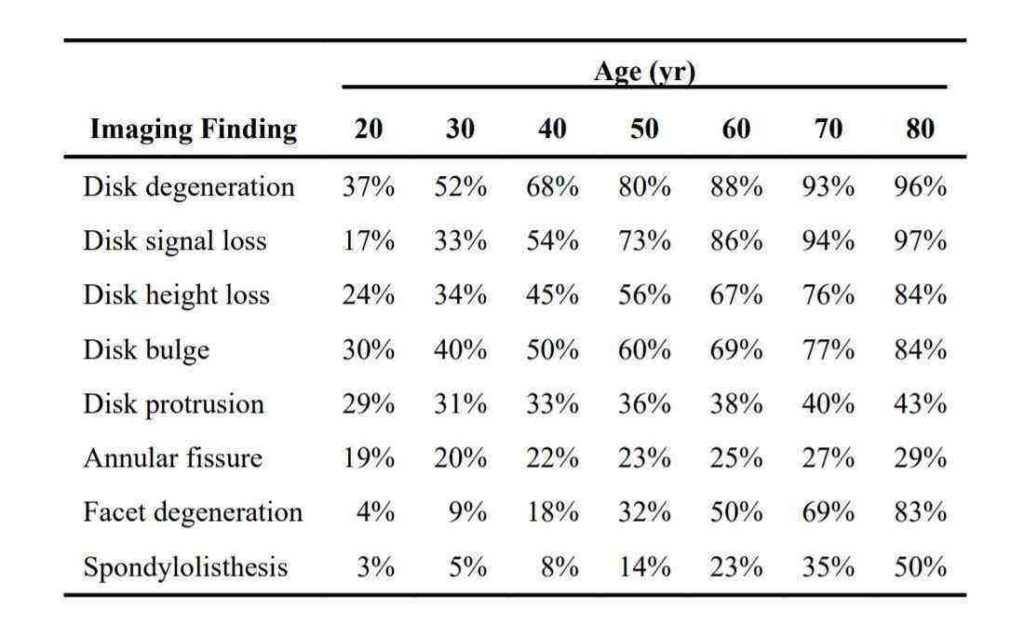
Find more about when an MRI scan is recommended for lumbar spine spondylosis in this article here.
How Does Lumbar Spine Spondylosis Happen?
In the case of lumbar spine spondylosis, age-related degeneration is witnessed in the lumbar discs.
With time, the spinal discs dehydrate and shrink, losing their lubrication.
Imagine a door which has been opened and closed continuously for 40+ years. Over time, the oil which greases this movement (like our cartilage) is worn away. This leaves nothing to protect the connecting parts of the hinge as they move back and forth. These parts are left to grind against each other, wearing away the supportive structures (of our spine in our case) which causes us pain and limits our capacity for movement. As such, our movements are made stiff, as they lack the substance which would otherwise help the joints glide.
Ageing in and of itself is not the root cause of spinal spondylosis. Instead, ageing is often associated with the development of ARTHRITIS – a condition whereby inflammation and/or degeneration is observed at the joints (the areas where two bones meet).
The most common form of arthritis associated with lumbar spine spondylosis is osteoarthritis, a form of arthritis conveniently labelled “wear and tear arthritis” – when this affects the spine, this falls under the umbrella of spondylosis.
“Osteo-” is the prefix for medical problems pertaining to bones – so, osteoarthritis describes changes to, and degeneration of, cartilage between the bones which form joints. Roughly 80% of individuals over 55 years old demonstrate evidence of osteoarthritis (ref 1). However, only 60% report experiencing symptoms as a result (ref 2).
Both spondylosis and osteoarthritis are classified as degenerative diseases, due to the irreversible structural and functional deterioration witnessed at the joints.
The following processes are often witnessed with lumbar spine spondylosis:
- Break down of the cartilage which cushions the vertebrae, causing the bones to grind together
- Disc dehydration which can cause the discs to shrink or crack; cracks allow the jelly inside the disc to escape which can then press on surrounding nerves
- Development of bone spurs, called osteophytes, on the vertebrae which reduce the space in the spinal canal and compress against the nerves
Wear and tear, and gradual bodily deterioration, is unavoidable.
Nevertheless, there are factors that can contribute to the onset of osteoarthritis and lumbar spine spondylosis:
- Sports participation: especially in high-impact sports, sports participation can accelerate the deterioration of the supportive spinal tissue.
- Injury: spinal injury can cause drastic damage or catalyse deterioration of your spine, bringing about spinal spondylosis. However, this is more likely to induce deterioration in one area, coinciding with the injury location, rather than throughout the entire spine.
- Your occupation: jobs requiring a lot of physical movement and strain, place your joints under pressure for long periods of time, speeding up the deterioration.
- Your weight: managing our weight is important, as extra weight adds extra pressure to our spine. The greater the load that our skeletal system must support, the quicker we wear down the materials cushioning that structure.

Treatment for Lumbar Spine Spondylosis
When I refer to treatment, I mean measures that can be taken to reduce the symptoms of lumbar spine spondylosis – they cannot cure it. Unfortunately, the degenerative changes which alter the structure of the spine are permanent, making spondylosis irreversible.
However, all is not lost – we can improve the symptoms, even if we can’t rebuild the physical structures in the spine.
I’ve had many testimonials from people with lumbar spinal spondylosis using my programs and getting a great outcome, as well as new strategies to control their symptoms when they arise. So, it’s definitely worth the effort of finding a proper rehabilitation program if you have lumbar spinal spondylosis.
Let’s have a look at some of the things that you can do to ease the symptoms and soothe the pain you may be experiencing.
#1 Successfully Diagnose the Problem
As stated before, spondylosis describes a cluster of spine related conditions. The degeneration of discs from wear and tear is not reversible. However, with the correct treatment, some of the problems under the umbrella of spondylosis, such as sciatica and bulging or herniated discs, have shown great improvement and/or healing.
Identifying what the root of the symptoms you are experiencing is the first step to correctly designing an effective treatment and/or pain management plan.
Remember, many people over the age of 40 will be experiencing some degree of disc degeneration, but many will not experience symptoms until the problem has significantly impacted the structure and the function of the surrounding joint.
Because of the symptomatic crossover between many spinal conditions, you may be required to have some tests to identify whether what you are experiencing is lumbar spine spondylosis.
It is worthwhile visiting a medical professional for a firm diagnosis as each condition requires a unique approach to be managed, or sometimes resolved, successfully.
Tests could include:
- X-ray: allowing the doctor to identify reduced structural space caused by erosion of the cushioning structures and/or growth of bone spurs
- CT scan or MRI: imagining tests which offer more comprehensive insight into structural changes
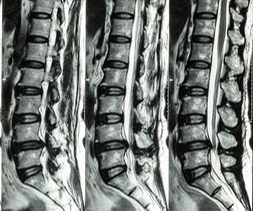
#2 Exercise
Physical therapy is one of the most promising treatments for lumbar spine spondylosis.
A proper rehabilitation program will help people with lumbar spine spondylosis by doing the following:
- Improving the flexibility of the muscles in the legs and reducing the “pull” on the spine so you can walk for further before pain
- Relieving tension in the back muscles and reducing back pain
- Improving fitness capacity so you walk for further with perfect technique, delaying pain
- Improving flexibility in the spine which lubricates the joints that the nerves run through
- Restoring health to the pinched nerves and reducing leg pain
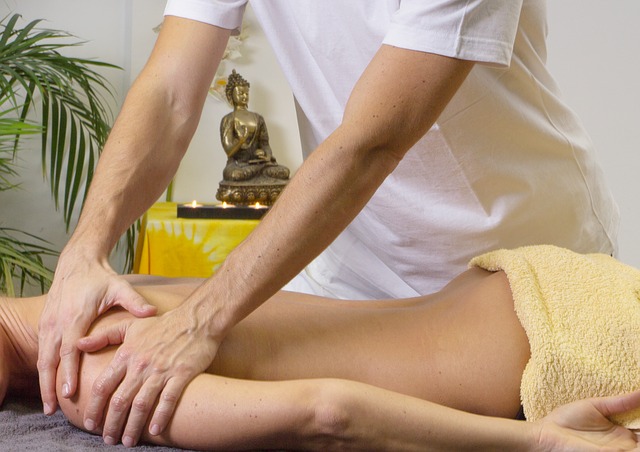
Speaking of excellent physical therapy programmes for lumbar spine spondylosis, my good friend, colleague and fellow international sciatica expert, Dean Volk, has a brand new sciatica relief video course available – and I’m delighted to be an official sponsor!
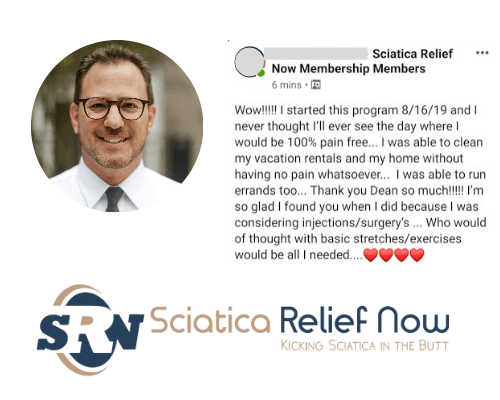
Check out Dean Volk’s “Kicking Sciatica OUT of the Butt!” Online Pain Relief Course Here!
I can proudly recommend Dean and his course for sciatica sufferers – because I’ve seen his incredible results first-hand. You can check out his course (and get lifetime access to the videos and bonus content) by clicking HERE.
#3 TENS Machine
Many of my patients with spondylosis find that a TENS machine can help to relieve their symptoms, when used alongside prescribed exercises.
A TENS machine works by sending a small electrical signal into the muscles of the back, providing pain relief in many cases, and loosening tight muscles.
TENS machines have demonstrated great success with pain relief for sciatica, one of the symptoms of lumbar spine spondylosis.
Below are my top 3 recommended TENS machines:
Before we dive in, please be aware that we are part of the Amazon Affiliate programme. The following are Amazon affiliate links, so if you choose to purchase a product for your spondylosis that we recommend through a link on this page, we will receive a small commission at no extra cost to you. This helps us keep Overcome Sciatica alive! Thank you for your support. Please be assured that we only ever recommend products that we truly believe can help.
1. TENSCare Perfect TENS Pain Relief Machine

This TENS machine has 8 pre-set programmes, so you don’t need to “tune it” yourself – just pick a setting and off you go! There is an option to purchase a ‘Value Pack’ which includes spare pads which I would definitely recommend.
Click HERE to view the TENSCare Perfect TENS Pain Relief Machine on Amazon US (closest match)
Click HERE to view the TENSCare Perfect TENS Pain Relief Machine on Amazon UK
2. SHANGPS TENS Machine for Pain Relief

The SHANGPS design has revolutionised the way TENS machines are used for lumbar spine spondylosis, meaning you can now get effective pain relief on the go to help reduce the disruption that spondylosis causes to everyday life. With its discrete design, the machine can sit comfortably on your lower back and be easily concealed under clothing and continue with your day-to-day tasks without having to stop and sit down to use a TENS machine for pain relief. Purchase with spare pads for the best value for money.
Click HERE to view the SHANGPS TENS Machine on Amazon UK
USA: Click HERE to view the closest alternative in the US on Amazon
3. TPN 200 Plus TENS Machine

A super-simple yet sleek design, this TENS machine is perfect for those who want a highly effective model and are confident with using a TENS machine for pain relief. This unit doesn’t have a fancy display, so you can customise the settings to best suit your needs, tweaking and changing the frequency until you find one that works best for you.
Click HERE to view the TPN 200 Plus TENS Machine on Amazon UK
USA: Click HERE to view the TPN 200 Plus TENS Machine for Sciatica on Amazon
#4 Pharmaceutical and Surgical Intervention for Lumbar Spine Spondylosis
There are a range of pharmaceutical options your medical specialist might offer to help relieve some of the pain or discomfort you are experiencing.
The following are some interventions and their benefits:
- Non-Steroidal Anti-Inflammatory Drugs (NSAIDs): many NSAIDs are available over the counter, Ibuprofen being the most common. These medications provide pain relief by targeting inflammation which may be causing aches and adding pressure to your nerves. However, your medical specialist might prescribe some stronger or longer lasting NSAIDs, such as Naproxen.
- Anti-seizure drugs: often prescribed to help manage the pain resulting from nerve damage (gabapentin or pregabalin are examples of effective anti-seizure medications)
- Epidural Steroid Injection (ESI): offering powerful pain relief, found to be most helpful for the legs, ESIs are administered to the epidural space which surrounds the spinal nerves.
Alternatively, although we want to avoid surgery, sometimes it may be the only option for relief. There are surgical treatments which can help relieve symptoms:
- Laminotomy or laminectomy: there are 10 laminae in the lumbar spine. A lamina is a part of the bone surrounding the back of the spinal cord. Partial segments of a lamina can be removed to relieve pressure on the spinal nerves – this is called a laminotomy. In more extreme cases, an entire lamina may be removed to increase the space around your spinal cord. This is known as a laminectomy (or decompression – which describes the reversal of the nerve compression).
- Disc replacement: although a relatively new advancement, one procedure now possible is the replacement of damaged discs to restore support for spinal movement and stability
#5 Focus on Improving Your General Health
If you’re struggling with your mobility due to spondylosis, one thing that might help is to address other general health issues like your weight, your diet, and your general exercise.
For example, staying hydrated is incredibly important for your overall health, as well as your intervertebral disc health. Drinking at least 2 litres of water per day is essential protect your discs from dehydration.
If you’d like some tips on how to improve all of those aspects of your health, stave off injury and treat problems like arthritis, you can grab a copy of my brand-new book, Thriving Beyond Fifty. You can see more details below:
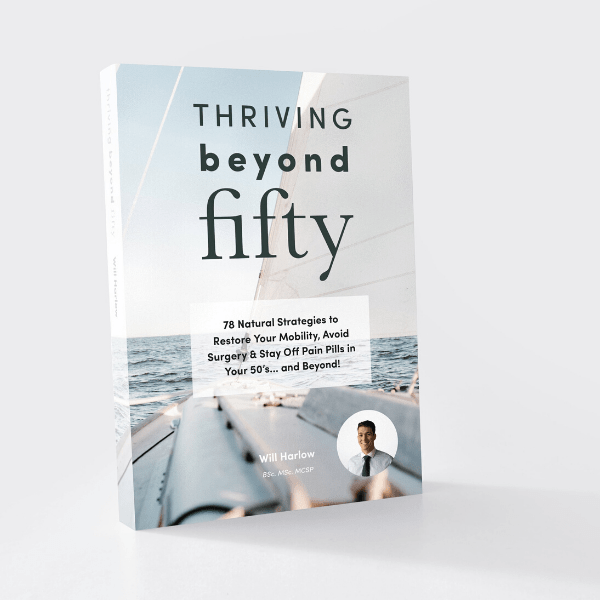
Top Tip: Grab a copy of my #1 Best-Selling book, Thriving Beyond Fifty for more health, wellness and recovery strategies!
Click HERE to view the book on Amazon UK!
Click here to view the book on Amazon USA!
Summary
Lumbar spine spondylosis, the unavoidable consequence of aging and remaining active, can lead to a host of problems which can disrupt everyday life. As spondylosis is a degenerative condition, its irreversible nature can be very daunting.
Remember, you are not alone – many people are experiencing the same thing. Make use of specialists, such as I, and the experience we have to offer to reduce your suffering!
References 1 https://www.nhs.uk/conditions/osteoarthritis/ 2 https://my.clevelandclinic.org/health/diseases/5599-osteoarthritis 3 https://www.nhs.uk/conditions/transcutaneous-electrical-nerve-stimulation-tens/

